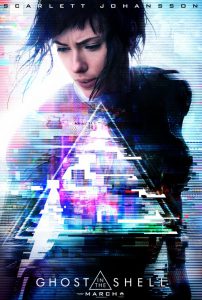Ghost in the Shell (2017) – Film Review

Ghost in the Shell is a live-action adaptation of an original Japanese Anime from 1995 set in a future where cyberpunk was all the rage.
Cybernetic augmentations are commonplace in the future and work on a full cyborg is proceeding at pace in one of the megacorporations that dominate – Hanka Robotics.
“Major” is the first successful cyborg created by Hanka, one of many to come, and she joined a special police unit called Section 9 to fight cyber terrorism.
With the upside of directly connecting brains to the ‘internet’, comes the downside of vulnerability to hacking.
A threat emerges, that of a super-hacker who appears to be attacking and killing Hanka scientists, and Section 9 are tasked to investigate but they find something much darker than just a hacker.
There’s been a lot of controversy over accusations of “whitewashing” following the casting of Scarlett Johansson in the role of “Major” in Ghost in the Shell – a role which some people have interpreted to require a Japanese actress.
Along with the furore raised over Matt Damon appearing in “The Great Wall” earlier this year the simple fact is that without a known Hollywood star signed up many films simply wouldn’t get made.
There’s just enough wiggle room in the script for Ghost in the Shell for this to have been hand waved away but the producers chose well for the the lead in this film.
Johansson has a solid track record in action films with her role as “Black Widow” in various Marvel Avengers films and the science fiction genre starting with The Island (2005) but also including Under the Skin (2013), Lucy (2015), and a turn as a Siri-like AI in Her (2013).
Ghost in the Shell uniquely Japanese in look
Ghost in the Shell looks really stylised in a gritty, exotic and uniquely Japanese at times – the opening five minutes show just how different the world of Ghost in the Shell is right down to the pseudo-naked “Major” action scenes.
The film itself is largely respectful to the Japanese anime original, with heavy visual nods to Blade Runner and The Matrix, Johansson working hard to look the part, and mixed in with bits of Total Recall to boot.
There are a couple of stellar cameos with Japanese cinema legend Takeshi Kitano (Battle Royale, 2000) as Major’s wily police section chief and Juliette Binoche as a scientist behind the creation of Major while Danish actor Pilou Asbaek lends some character to the role of Batou.
The problem is that the story seems a little distant and simplified, even diverging from themes set up in the original to follow its own path.
Instead, this version leans heavily towards a clinical retread of elements from Robocop with scene setting by The Matrix (which itself was heavily influenced by the original Ghost in the Shell) offering very little that sci-fi fans haven’t seen before.
Fans of the original may notice entire scenes from the original movie making their way into this film but then wonder about what they are doing in a narrative which increasingly diverges from the original.
New story threads introduced in this film are allowed to pass the film by as the plot touches on potentially new material but doesn’t follow them up.
While the plot may not hold together on closer inspection it’s perfectly serviceable watch and not one to get too precious about over the pacing, plot lines – and there are one or two underdeveloped ones in the film, look and feel, or wars over casting decisions.
Ghost in the Shell (12A; moderate violence, threat; 107 minutes)
Summary: GHOST IN THE SHELL is a sci-fi action fantasy in which a woman awakes to discover her mind has been transplanted into an android body.